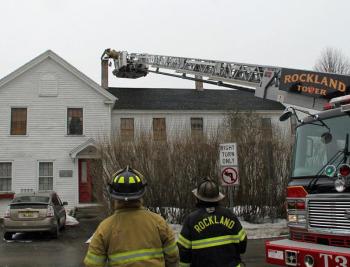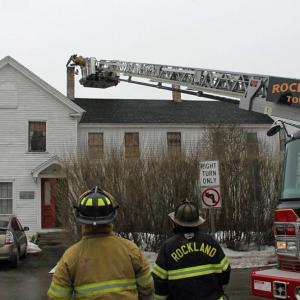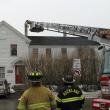Burning debris trapped at top of chimney source of smoke, fire in Rockland
ROCKLAND — Even the smallest fires, and those that extinguish themselves, provide an opportunity for full-time firefighters to stretch their legs, run equipment and practice skills. A reported chimney fire at 7 Talbot Ave. in Rockland, between Union and Main streets, presented just such an opportunity Monday afternoon.
The chimney fire call came in at 12:27 p.m. and eight people from Rockland Fire Department responded. They arrived on Talbot Avenue with two engines, the ladder truck and an ambulance, along with the chief and his squad truck.
Chief Charlie Jordan said the cause of the fire was combustibles in the fire place, which went up through the lined chimney and got caught on the screen at the top.
"It burned brilliantly at the top for a few seconds, prompting the call," said Jordan. "It was essentially out when we got there, but we went up and checked that the debris was out and the chimney was clear."
Jordan said that while the call ended up being not a very big deal, it could have been.
"It was a legitimate call, just not a really big chimney fire. The lined chimney was real clear, but had it not been, the burning debris could have caused a real problem," said Jordan. Burning debris ascending a dirty can ignite creosote and other trapped
Jordan also said going to the call was better than sitting around the station.
"We got to go out, extend the ladder, go through the drill and make sure everything was all right," said Jordan.
From start to finish, the call took a little more than a half-hour, with all units clearing the scene and returning to the station at 1:03 p.m., according to Lt. Jamie Leo.
Chimney fire information:
Residue deposits inside a chimney must be periodically cleaned out to rob a chimney fire of its fuel. This creosote is created by incomplete combustion of fuel in the fireplace or wood/coal stove. Inadequate heat and oxygen causes the unburned fuel to be converted to vapor, which travels up the chimney where it makes contact with the cooler surface. At that point, it turns to creosote, which is a tar-like substance that adheres to the inside of the chimney.
As more and more layers of creosote accumulate, the chimney can either become plugged or the creosote inside it can reach a temperature and oxygen level that allows a fire to ignite.
Signs of a chimney fire include loud cracking and popping noises, a lot of dense smoke and an intense, hot smell. According to the Chimney Safety Institute of America, homeowners have reported being "startled" by hearing a low rumbling sound like a freight train or a low flying airplane. Chimney fires can also burn noisily and dramatically enough that neighbors and passersby are the ones to notice them before people inside the home do.
For more information on chimney fires and how to avoid them, visit www.csia.org. For general fire safety, visit the National Fire Protection Association's website at www.nfpa.org.
Event Date
Address
7 Talbot Avenue
Rockland, ME 04841
United States


























